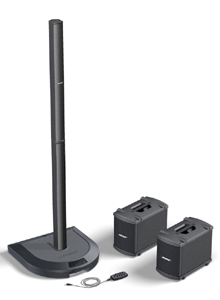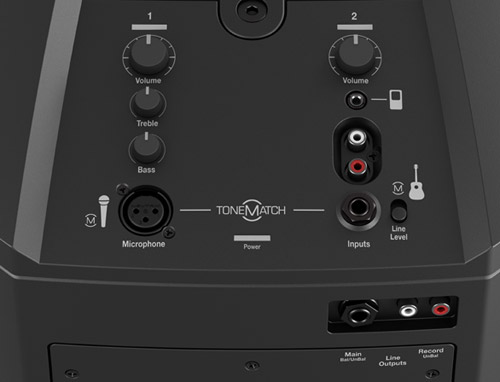BOSE L1 Compact System Review
From The Mobile DJ Perspective |
by Cap Capello,
30 year career full-time Mobile DJ veteran, 5 year user of the L1 system,
and BOSE L1 Dealer |
|
| Part One - System Overview |
|
The L1 Compact is to the L1 Model 1 or L1 Model 2
what the Whopper Junior is to the Whopper ...or... what the Boeing 727
is to the Boeing 747. |
|
L1 Compact |
|
L1 Model 1 |
|
L1 Model 2 |
|
|
 |
|
 |
|
 |
|
|
|
|
|
|
|
|
It carries easily in one hand and one shoulder (about 30 lbs in total)
and is well protected by the [included] padded base/powerstand cover
and the over the shoulder strap extension tube
bag.
The base/powerstand is the guts and the brains of the L1 Compact, housing
a two channel mixer [1 xlr mic input, 1 multi-source input], two high efficiency
amplifiers, a single 8" bass driver [down to 65hz], and the removable
articulated 6 driver line array module. It is ruggedly constructed and
will withstand the rigors of a traveling mobile DJ or musician.
Documentation previously provided clearly illustrates use and types of
input and output sources, however let's get into them again,
explaining the various sources for further clarity. |
| L1 Compact I/O Panel |
 |
|
|
|
|
|
|
|
The 1st input is an xlr jack for a microphone ONLY. It is system pre-EQd for voice yet does have three knobs for further fine tuning; one for highs, one for lows , and one for volume. In our tests we used a wired Shure Beta 58.
The 2nd input is for the source and all can be connected at the same time,
one does not override the other; 1/4" t.r.s. (switchable to line level
or mic level), red & white rca, .38mm stereo). This means that a mic
could be connected, EQd, and controlled in channel one, while channel two
could have a balanced 1/4" output from a DJ mixer as well as a laptop
as well as an iPod, all plugged in at the same time, all being
singularly volume controlled with one channel two volume control knob.
Each channel has a clearly visible green led bar when in normal operation,
will flash red when begins to reach its limits and becomes solid red when
the source volume or channel volume causes clipping.
There are also two outputs; red & white rca and 1/4" t.r.s. This would be ideal for daisy chaining several L1 Compacts using standard rca cables and/or 1/4" balanced cables as well as concurrently adding a powered sub.
The two extension tubes are specifically designed to elevate the 6 speaker
line array module higher in the air, over the heads of those within a couple
of yards direct in front in order to project sound farther and deeper. The
aproximately 180 degrees of left and right solid, clear, quality
sound dispersion throughout a room is mind boggling.
For typical mobile DJ applications, the extension tubes are crucial as
will be explained in further detail in a bit. For use as a small-to-medium
sized conference or meeting system and combined laptop/projector PowerPoint
or other presentational audio output device, the flexibility and diversity
of a single Compact system provides all that one would need. |
|
|
|
|
|
|
|
|
|
|
 |
|
|
|







